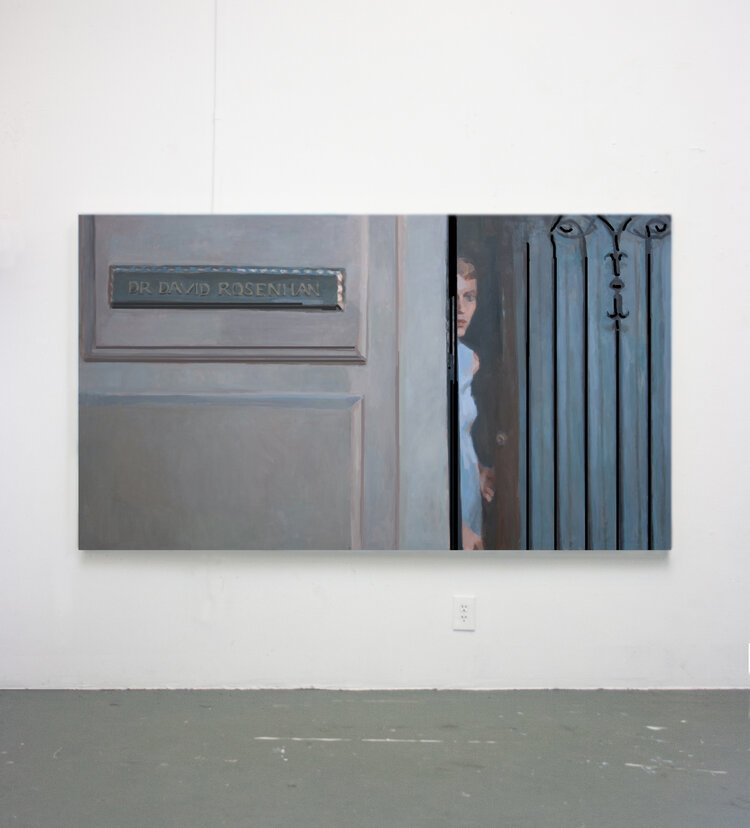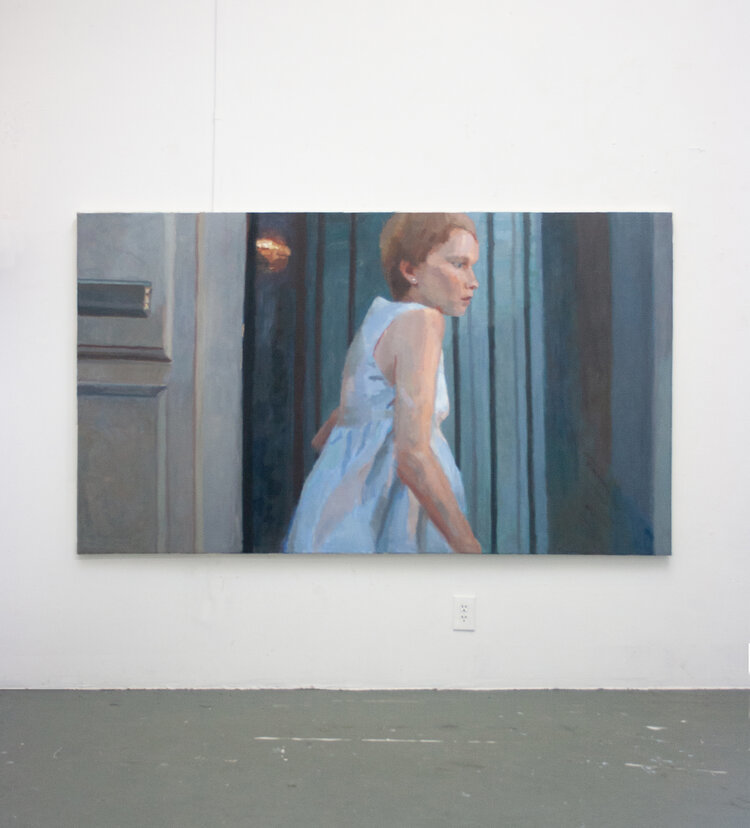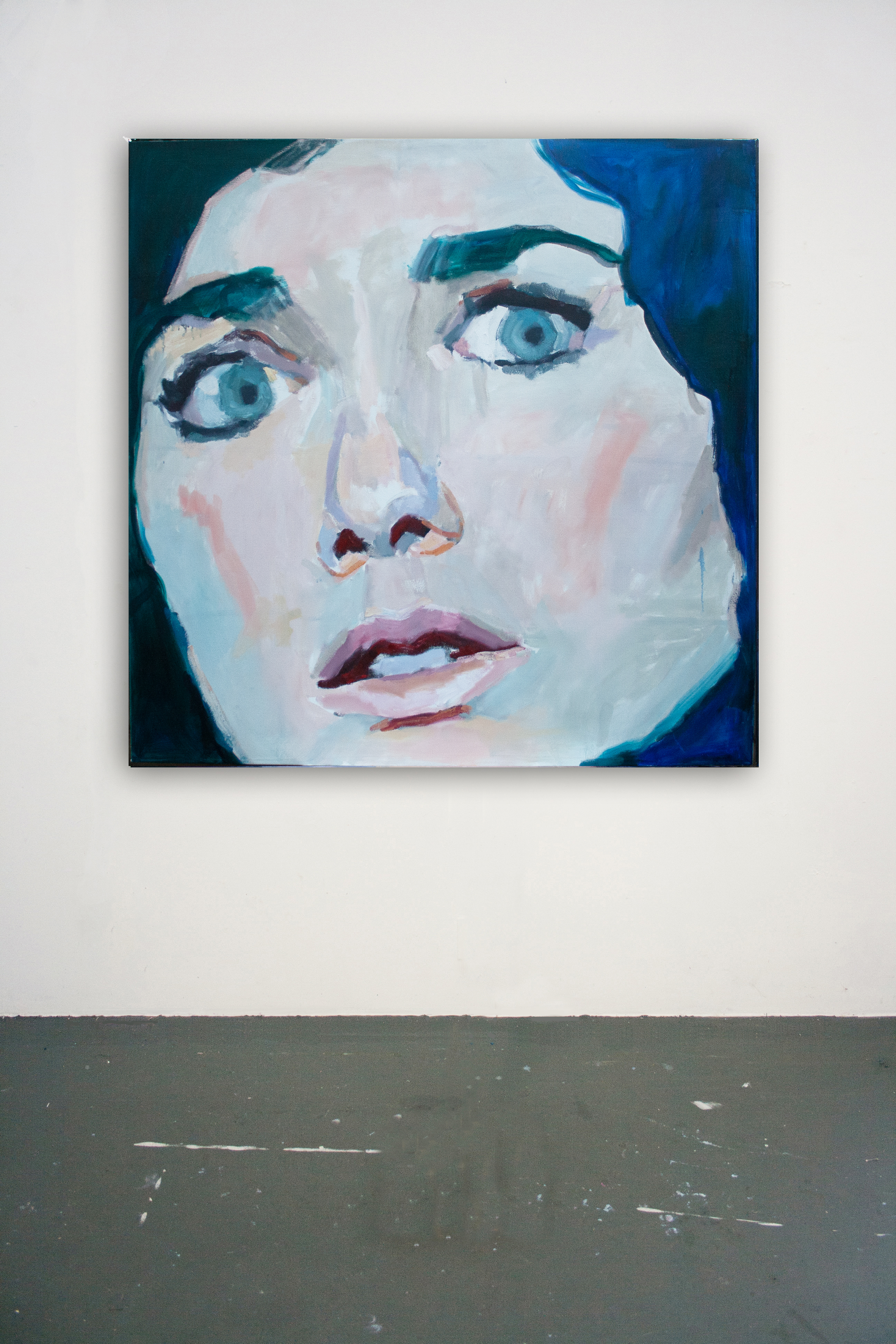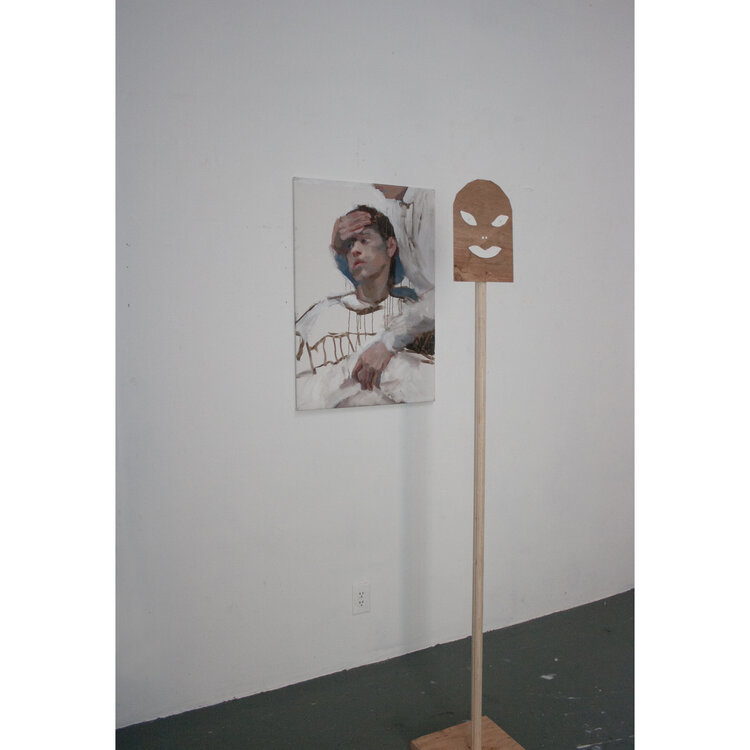INTERVIEW: MORGAN OGILVIE
JAN. 24, 2022

INTERVIEW: MORGAN OGILVIE
JAN. 24, 2022
Rachel Bubis: Your work examines sinister social forces seen through the lens of “unreliable” female protagonists in culture - anti-heroines such as Martha Mitchell, the wife of Nixon’s attorney general, Rosemary, from Rosemary’s Baby, Typhoid Mary, and most recently, Suzanne Pleshette's character in an early episode of Columbo. What draws you to these figures? When did this interest begin?
Morgan Ogilvie: Moving to Los Angeles county in 2018 to attend the MFA program in painting at CalArts amplified my interest in paranoia and the difficulty teasing fact from fiction when one's surroundings are so opaque. Living that close to Hollywood, and especially when social media platforms are so ascendant, it was easy to imagine that I was living amongst performers and that "All the world's a stage.”
I remember early in the pandemic, while still in California, we were watching a satirical news segment, and I learned that television medical dramas were donating masks to the pandemic response. To repeat: a parody accurately informed me that pretend doctors are coming to the aid of a real world-wide medical emergency which should have been handled by a reality television President. Understandably, this kind of spectacle gives tragic rise to ludicrous conspiracy theories, and falsehood and fact start to mix and mingle in a really problematic fashion.
This bizarre atmosphere certainly inspired me to reexamine Rosemary’s Baby. In LA, I started to identify with Rosemary - not because I believe I am going to give birth to the spawn of Satan, but more because she is trying to decipher larger, perhaps sinister, forces afoot. And for better, or worse, a lot of people feel like that. In that sense, she’s a good muse for the moment.
These female characters - like Martha Mitchell, the Arkansas-born wife of President Nixon’s attorney general, who was trying to tell the world about Nixon’s crimes and was slandered, delegitimized, drugged and held captive in Los Angeles by rogue government actors - are so endlessly fascinating to me because they hold onto their truth while no one believes them.
On a lighter note, when I was living in LA, there was the sound of a giant bird in the neighboring apartment complex, which was advertised as pet friendly. I swear this squawk had to be a special-effect, it was so loud, how could they have a six-foot bird in their apartment? Then, one day it stopped and we never got to solve the mystery. LA is like that. You feel like you are on a set. This bird, if it was real, had to be, like, a GINORMOUS CREATURE!

Morgan Ogilvie, (Painting of woman in blue dress peeking out of doorway) Part of series This is No Dream, Still 1, 4 x 7 ', Oil on Canvas, 2019.

Morgan Ogilvie, (Painting of woman in blue dress, clearly pregnant, walking) Part of series This is No Dream, Still 2, 4 x 7'. Oil on Canvas, 2019.
RB: Why do you think women are often portrayed as the “unreliable narrator”?
MO: There are certain qualities that make a person easier to frame as unreliable and some of these are what in recent history were considered “feminine.” I think some of these qualities can be weaponized against women. I am naturally shy and unsure of myself, so perhaps I am not a particularly convincing person, though I don’t think I am considered unreliable. With Rosemary, she is not only female, but quite childlike making it even easier to dismiss her.
“Groupthink,” or a charismatic leader, often dictates “reality” or unfortunately leads us to choose “alternative facts.” Often, a “truth” receives privileged status due to how convincing the person’s presentation is rather than how empirically sound the person is. Charisma or status or style can usurp evidence, etc.
A hilarious anecdote that speaks to this topic is the now defunct “George Washington Birthday Celebration” that used to occur at my all girls middle school from 1922 until 2020. It is this crazy pageant that maybe would have seemed more normal in 1922, but felt really out of place and had more in common with contemporary art performance than ever intended. Because this school is all girls, all of the male and female roles are all performed by the 7th grade girls. George and Martha, both girls, all of the founding fathers, girls. So, at some point in recent history (I wish I could give you a date) only the male characters had speaking parts! They of course corrected for this, but it is such a glaring, and I think funny, example of messages that were sent to girls, how we thought of separation of duties and how we are unlearning these patterns. It is a messy process.
RB: You paint the same image/scene multiple times, for example, in this is no dream (2019), you created paintings culled from three seconds of footage from Rosemary’s Baby, using repetition to invite viewers to question their own reasoning. Have you found yourself questioning your own reasoning through this process? Have you gained any insights into these people or characters through the creation of your work?
MO: This is another really great question. No matter how many times I paint the same image over and over again, I still may not get any closer to solving certain riddles or arriving at “ultimate” truth. As with Hamlet, who was told by a ghost that his father was murdered, one interpretation with regards to Rosemary is she is deluded, and her son is not really Satan’s spawn. After painting her so many times I still can’t categorically reject these intriguing conjectures.
I have painted Suzanne Pleshette at the moment she first doubts herself in this very resonant episode of Columbo, where she witnesses a murder. What I find so difficult personally is you don’t always know when to hold onto intuition, and when to engage in more traditional scientific rigor. When to listen to reason, and when revelation? I think both ways of knowing the world are important. But, it is definitely cathartic to kind of commune with these fictive characters. These paintings hopefully provide a healthier outlet to sit with these complicated feelings about a very tumultuous time.
You know the phrase life imitates art? Don’t watch anything you’re not ready to start see echoing across your own life. We watch kitschy mysteries, and there’s a lot of wisdom in even the schlockiest iterations of this genre.

Morgan Ogilvie, Through the window, From a distance, I saw him murder a man, Oil on Canvas, 48 x 48", 2021.
RB: In Ammalati, you paint a young woman whose photo can be found in the archives of The Museum of Madness, in Venice, Italy. In front of the painting stands a mask, inviting the viewer to look through it at the painting. Can you talk more about the mask and the access you hope it gives in connecting to this figure?
MO: The mask is based on a piece of artwork created by one of the convalescents at this sanatorium in Venice, Italy. The etymology of the word person comes from persona, meaning an actor’s mask. This inextricably links our own personhood to the idea of a mask. The mystery writer Agatha Christie said “The human face is, after all, nothing more nor less than a mask.”
The history of the word mask comes from “Masca,” which meant soot associated with witchcraft. Furthermore, it has often been used in rituals to communicate with the dead. Therefore, the mask has historically linked humanity to the underworld and even to magic. So, hopefully, I suppose the mask might be a kind of talismanic portal to another world.
I want to compare the magic the mask can hold with the different ways a person with mental illness might see the world. Maybe they have a “magic” that we don’t understand. In my own life, I have had extended family members who had schizophrenia, but they were simultaneously incredibly intelligent and quite charismatic.
We don’t always see people with disorders clearly. It is easy to see “them” as an “other” and we can accidentally create false dichotomies between their human experiences and our own. This mask is a physical manifestation of this fraught distance.
On the other hand, the mask can also be used for protection - as we know all too well in this pandemic. In this way, her mask can also be seen as a form of protection from the world around her.
There’s a multiplicity of meanings I hope people encounter; there’s no “right” answer.

Morgan Ogilvie, (Painting with a mask in front of it) 1F Ammalati (Sick), Oil on Canvas with wood and paper cutout, 2019. 24√2 x 24 " (which approximates to 34 x 24 in.)
RB: You describe Mia Farrow in Rosemary’s Baby as a muse for our cultural moment, where “conspiracies and fear are playing an outsized role in the public consciousness and dark imagination.” How do you stay sane in such a society marked by conspiracy and confusing information? Does making this work help?
MO: This is another excellent question. I don’t ever watch traditional television news or use social media to stay abreast of current events - I only read or listen to the news on one or two outlets. I even limit my NPR listening (even though I love this organization).
This body of work has been really grounding because, when I show it for critique, everyone seems to be on the same page in terms of believing this is a really bizarre historical moment. Since about 2016, I feel like I am living in history and I never really felt that way before.
I had some absolutely lovely professors at CalArts, like the painter Thomas Lawson, my mentor who was incredibly supportive, John Mandel, and Charles Gaines - who was absolutely amazing - but as a more strictly conceptual artist - was not feeling Rosemary at all :). He had never seen the movie and when I showed him the early stages of the work, he said “this means nothing to me,” referencing the illegibility of the work beyond the film. This is jarring to hear from one of the most prestigious artists alive, but he was absolutely right, of course, so I figured out ways to communicate my themes better. (Still working on this, though he still might hate the Rosemary work!) He took the whole class out for dinner at Chili’s at the end of the semester and let some students ride in his Tesla there, and it was one of the most entertaining meals I have ever had. So, great meal, pretty bad crit!

Morgan Ogilvie, (Painting of a little girl in a cape) "Even when she was a little girl, she had a vivid imagination." 21 x 11", Oil on Canvas, 2021.
RB: You describe the act of painting as a “fervent desire to worship at the altar of a singularly strained and fraught spot of time,” and quote the poet Charles Simic: “It is the secret wish of all poets to stop time.” I love this quote and I think many artists can relate. Have you always had this desire?
MO: First of all I am so excited that you like this quote. My husband actually studied with Charles Simic in graduate school, and the two were fairly close. What’s not to love about a semi-demented poet from the former Yugoslavia? I think he is very right about the artistic wish to stop time.
Painting does feel like you are capturing a moment, maybe even more so than the act of taking a photograph since it takes more time to apply the oil to the canvas. I used to think of it as trying to understand whoever I am painting - and somehow through this deliberation, and meditative act, at the end, I would somehow know the “truth” of that person. It doesn’t work that way, but I think on some level it is a continuously searching act.
RB: What are you working on now and what’s next?
MO: I have been participating in a long distance residency, Art Lab, led by Michael Swank, a gallery owner, who has been lovely to work with. This residency culminated in my body of work entitled “The Eye is Not Satisfied with Seeing” and it will be going to Mexico City for a show at his gallery, PRPG.MX, February 10th. I will also be there during Zona Maco, one of the largest art fairs in the world. I’ve never been to an art fair or Mexico City, so this will be really fun. (Obviously, this may be canceled due to the pandemic - but as of my writing this, we are still going and will limit what we see based on safety precautions.) Then I am likely going to LA in February to see some of my cohort from graduate school at CalArts and some of the amazing faculty there.
Morgan Ogilvie received her MFA from the California Institute of the Arts (CalArts) and is currently on the Alumnx council for 2021 (though she resides in Franklin, Tennessee). She has work at Ron Howard and Brian Grazer’s Imagine Entertainment in Beverly Hills, CA. Her paintings have been published in the 2020 issue of the Vassar Review themed “Protest, Prophecy, Play”. Her work has been selected to be published in the first of a three-part edition book series Art in the Time of Corona written by DAB Art Company founder, Yessica Torres. This past summer her work was shown in Artforum and she participated in and helped organize the group show, Time is Out of Joint, published in Hyperallergic, held at the MAK Center in LA, and curated by artist and composer Scott Benzel. Her work has been published in The Tennessean and featured in Nashville Arts Magazine, and the Nashville Scene. She was in the group show, Keep it Warm, at Zeitgeist Gallery in Nashville, TN. She has been honored to be in a group exhibition, Living the Archive, with the distinguished artist, writer, member of the Pictures Generation, and famous defender of figurative painting in the 1970s, Thomas Lawson, who was also her mentor.
Rachel Bubis is a Nashville-based independent arts writer, regular contributor to The Focus blog, and LocateArts.org Web + Print Manager for Tri-Star Arts.
* images courtesy of the artist


